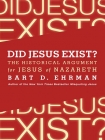Did Jesus Exist? - The Historical Argument for Jesus of Nazareth Bart Ehrman (books to read in your 20s txt) 📖

- Author: Bart Ehrman
Book online «Did Jesus Exist? - The Historical Argument for Jesus of Nazareth Bart Ehrman (books to read in your 20s txt) 📖». Author Bart Ehrman
The logic is tied to the apocalyptic understanding of the resurrection that I described earlier in this chapter. Paul was a Jewish apocalypticist even before he became a follower of Jesus. As such, Paul believed that God would soon intervene in history, overthrow the forces of evil, and bring in a good kingdom on earth. In thinking this, Paul was much like all the other apocalypticists from the time that we know about, for example, the authors of the Dead Sea Scrolls and of the various Jewish apocalypses. At this soon-to-arrive cataclysmic end of the age, a judgment would be rendered on all people, leading to judgment of some and condemnation of others. This would apply to both the living and the dead, at the future resurrection. The idea of the “resurrection of the dead” was an apocalyptic idea shared by a wide range of Jews, like Paul, even before he was converted. The key point is this: the resurrection was to happen at the end of this age.
For Paul, Jesus’s resurrection—this end-of-the-age event—showed that the end had already begun. That, as we saw, is why Paul calls Jesus the “firstfruits of the resurrection” in 1 Corinthians 15:20. After the farmer gathers the firstfruits on the first day of harvest, when does he gather the rest? Does he wait a hundred years? No, he goes out the next day. If Jesus is called the firstfruits of the resurrection it is because all the others who are dead will soon—very soon—be raised as well. We are living at the end of time.
The fact that Paul thinks of Jesus as the firstfruits shows beyond reasonable doubt that he thought the resurrection was a recent event. It is not that Jesus—killed a hundred or more years earlier—had started to appear to people (including “apostles” who never knew him) here at the end. It is that he has been raised here at the end. The culmination of the end is therefore imminent. That is why Paul intimates that he will be alive when Jesus returns (see 1 Thessalonians 4:13–18). The recent resurrection of God’s messiah is a clear indication that the end of all things is virtually here.
And so both the literary character of 1 Corinthians 15:3–5 and the logic of Paul’s understanding of the resurrection show that he thought that the life, death, and resurrection of Jesus were recent events. I should stress that this is the view of all of our sources that deal with the matter at all. It is hard to believe that Paul would have such a radically different view from every other Christian of his day, as Wells suggests. That Jesus lived recently is affirmed not only in all four of our canonical Gospels (where, for example, he is associated with John the Baptist and is said to have been born during the reign of the Roman emperor Augustus, under the rulership of the Jewish king Herod, and so on); it is also the view of all of the Gospel sources—Q (which associates Jesus with John the Baptist), M, L—and of the non-Christian sources such as Josephus and Tacitus (who both mention Pilate). These sources, I should stress, are all independent of one another; some of them go back to Palestinian traditions that can readily be dated to 31 or 32 CE, just a year or so after the traditional date of Jesus’s death.
Was Jesus Crucified in the Spiritual Realm Rather Than on Earth?
ONE OF THE STAUNCHEST defenders of a mythicist view of Christ, Earl Doherty, maintains that the apostle Paul thinks that Jesus was crucified, not here on earth by the Romans, but in the spiritual realm by demonic powers. In advancing this thesis, Doherty places himself in an ironic position that characterizes many of his mythicist colleagues. He quotes professional scholars at length when their views prove useful for developing aspects of his argument, but he fails to point out that not a single one of these scholars agrees with his overarching thesis. The idea that Jesus was crucified in the spiritual realm is not a view set forth by Paul. It is a view invented by Doherty.
It is rather difficult to respond to a book like Doherty’s recent massive tome, Jesus: Neither God nor Man. It is an 800-page book that is filled with so many unguarded and undocumented statements and claims, and so many misstatements of fact, that it would take a 2,400-page book to deal with all the problems. His major theses are set forth in a brief preface that lists “The Twelve Pieces of the Jesus Puzzle.” Many of the claims are problematic, and I have dealt with a number of them already. One particular piece is especially unconvincing: in Doherty’s view, Paul (and other early Christians) believed that the “Son of God had undergone a redeeming ‘blood’ sacrifice” not in this world but in a spiritual realm above it.25
Doherty’s reason for this remarkable statement involves what he calls “the ancients’ view of the universe” (was there one such view?). According to Doherty, authors who were influenced by Plato’s way of thinking and by the mythology of the ancient Near East believed that there was a heavenly realm that had its counterpart here on earth. “Genuine” reality existed, not here in this world, but in that other realm. This view of things was especially true, Doherty avers, in the mystery cults, which Doherty claims provided “the predominant form of popular religion in this period.”26 (This latter claim, by the way, is simply not true. Most religious pagans were not devotees of mystery cults.)
In the first edition of Doherty’s book, he claimed that it was in this higher realm that the key divine events of the mysteries transpired; it was there, for example, that Attis had been castrated, that Osiris had been dismembered, and that Mithras had slain the bull.27 In his second edition he admits that in fact we





Comments (0)